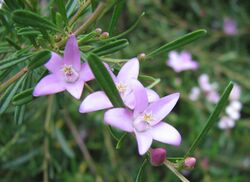Biology:Crowea
| Crowea | |
|---|---|

| |
| Crowea exalata | |
| Scientific classification | |
| Kingdom: | |
| (unranked): | |
| (unranked): | |
| (unranked): | |
| Order: | |
| Family: | |
| Subfamily: | |
| Genus: | Crowea |
| Type species | |
| Crowea saligna Andrews | |
| Species | |
| |
| Synonyms[1] | |
| |
Crowea is a genus of small evergreen shrubs in the family Rutaceae, sometimes known as waxflowers. There are three species and many subspecies and cultivars, all of which are popular as ornamentals because of their abundant, attractive flowers which often occur during autumn and winter. Crowea species are all endemic to Australia , where they occur in Victoria, New South Wales and Western Australia.[2][3]
Description
Croweas are evergreen shrubs to about 1.5 m tall. The leaves are simple, glabrous and, as with other members of the Rutaceae, have oil glands and are aromatic.[4] The flowers occur singly in the axils of the leaves, are pink and star-shaped have five petals, five sepals and ten stamens in two rings around the ovary. Crowea are closely related, and the flowers similar in appearance to those of other member of the family Rutaceae, especially Philotheca, Eriostemon and Boronia.[2]
Taxonomy and naming
The genus was described and named by James Edward Smith in 1798[5] and was named "to honour James Crowe esq., F.L.S. of Lakenham, near Norwich, who died Jan 16, 1807 aged 56. This gentleman was extremely well versed in the botany of Britain, more especially in the genus Salix, to which he paid particular attention, having collected and cultivated all the species he could possibly procure. The specific name of the original species, Crowea saligna alludes to Mr. Crowe's merits in this department".[6]
The three species are accepted by the Australian Plant Census as at November 2020:
- Crowea angustifolia Sm.[7] - Western Australia
- Crowea exalata F.Muell.[8] - Queensland, New South Wales, Australian Capital Territory and Victoria
- Crowea saligna Andrews[9] - New South Wales
Propagation and cultivation
Croweas are hardy in cultivation, moderately tolerant of frost, growing best in a well-drained mulch in partial shade. Propagation is easiest from cuttings.[10]
References
- ↑ 1.0 1.1 "Crowea". Australian Plant Census. https://biodiversity.org.au/nsl/services/apc-format/display/86715.
- ↑ 2.0 2.1 "The adaptable and rewarding Crowea". Australian Native Plants Society Australia. http://anpsa.org.au/APOL18/jun00-5.html. Retrieved 14 July 2017.
- ↑ "Growing Native Plants - Crowea exalata". Australian National Botanic Gardens. 1973. http://www.anbg.gov.au/gnp/gnp3/crowea-exalata.html. Retrieved 15 January 2015.
- ↑ "Flora of Australia online - Rutaceae". Australian National Botanic Gardens. http://www.anbg.gov.au/abrs/online-resources/flora/stddisplay.xsql?pnid=24012. Retrieved 15 January 2015.
- ↑ "Tropicos - Crowea (Sm.)". Missouri Botanical Garden. http://www.tropicos.org/Name/40017001. Retrieved 15 January 2015.
- ↑ Wilkes, John (1825). Encyclopaedia Londinensis Volume XX. John Wilkes. p. 264. https://books.google.com/books?id=AFwMAQAAMAAJ&pg=PA264&dq=crowea+angustifolia#v=onepage&q=crowea%20angustifolia&f=false. Retrieved 1 March 2015.
- ↑ "Crowea angustifolia". Australian Plant Census. https://biodiversity.org.au/nsl/services/apc-format/display/86750.
- ↑ "Crowea exalata". Australian Plant Census. https://biodiversity.org.au/nsl/services/apc-format/display/86803.
- ↑ "Crowea saligna". Australian Plant Census. https://biodiversity.org.au/nsl/services/apc-format/display/86846.
- ↑ Wrigley, John W; Fagg, Murray (2013). Australian native plants (6th ed.). Chatswood, N.S.W.: Reed New Holland. ISBN 9781921517150.
Wikidata ☰ Q2888343 entry

